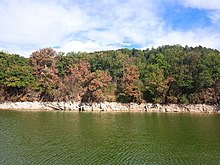2022 European drought
During the summer of 2022, parts of Europe experienced drought conditions exacerbated by heat waves.
[6][7] Scientists found that while precipitation deficits primarily caused the lack of water in the soil, human-induced global warming contributed to over 30% of the drought intensity and its spatial extent via enhanced evaporation.
[15] The Prime Minister of France Élisabeth Borne called it "the country's worst drought in history".
[20] In July and August Gironde experienced numerous wild fires, see 2022 European and Mediterranean wildfires.
[23][24] Due to the low water levels, the cost of transporting goods multiplied because ships were only able to load 25-35% of their usual freight.
[32] Low water levels in the Danube River exposed the wrecks of dozens of German warships, sunk in late 1944 to block passage to the Soviets.
[46] On 12 August, a drought was declared[47] in eight of the 14 Environment Agency areas: Devon and Cornwall, Solent and South Downs, Kent and South London, Herts and North London, East Anglia, Thames, Lincolnshire and Northamptonshire, and the East Midlands.
[50] A drought was declared in the West Midlands region on 23 August, with the Environment Agency warning it had been using groundwater resources and reserves from reservoirs in Wales to help maintain the flows of the River Severn, which supplies six million people in the area.
[52] On 18 August, a hosepipe ban in South West Wales was introduced affecting Pembrokeshire and parts of Carmarthenshire.
[55] On 19 August, a drought was declared in north Ceredigion, Teifi, Pembrokeshire, Carmarthen, Swansea, Llanelli, Neath Port Talbot and Bridgend.
[58] Parts of Yorkshire experienced their driest period on record and emergency pipes were laid.
[59] The Cornwall hosepipe ban continued to be active into 2023, and was extended to cover large parts of Devon on 25 April 2023.






